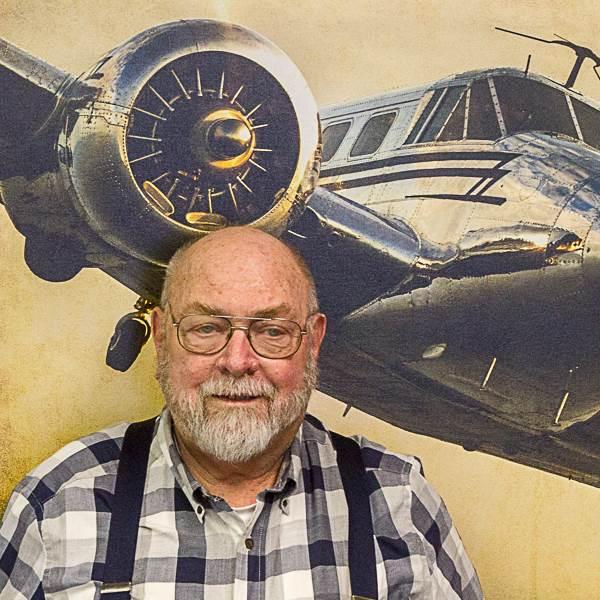Flying blind
The beginning of instrument flight

The airplanes today are mechanized to such a degree that the pilot no longer depends on the seat of his pants to the extent that he did in the early days. What has happened to aviation has happened to almost everything else. The day of the rugged individualist, the day of the inventor, is almost over. The Ben Franklins and Henry Fords are pretty much a thing of the past. It has just become too complicated. Everything now is a team operation, and if a truly new concept is developed, it means that there will be a large number of people knowledgeable in various scientific disciplines involved. And this requires a different philosophical outlook. I cannot see, for instance, how we could ever have another Lindbergh. Things have changed too much for that sort of competence to be rewarded the way it justifiably was. Still, I think that aviation will continue to develop, and each era will be interesting. But interesting in different ways.” —Gen. James “Jimmy” Doolittle
It was almost 95 years ago when a pilot first used instruments to fly an airplane without outside visual reference.
Most of the names involved in instrument flight development in the late 1920s are familiar to modern aviators: Harry and Daniel Guggenheim, Jimmy Doolittle, Elmer Sperry Jr., Paul Kollsman, and Ben Kelsey were the original team that made instrument flying, or “blind flying” as it was called at the time, possible.
The Guggenheim Foundation provided financial support for the development of aviation in the amount of $2.6 million, and one of the programs funded was instrument flight. Paul Kollsman developed the sensitive altimeter and Elmer Sperry perfected gyroscopic flight instruments. Instrumentation and equipment continually improved, and, in the latter half of 1929, flight test experiments were being designed.
The airplane selected as the flight test bed was a Navy NY–2 because of its power to handle the weight of the added equipment and its excellent handling characteristics. A larger generator was fitted on the airplane. Eleven instruments were installed in addition to the engine instruments. These were a magnetic compass, Earth induction compass (directional reference from lines of magnetic flux of the Earth), a turn-bank indicator, a directional gyro, an artificial horizon, an airspeed indicator, a Kollsman window altimeter, a rate of climb indicator, an outside air temperature thermometer, a vibrating reed homing range indicator, and a vibrating reed marker beacon indicator.
On September 24, 1929, at about 10 in the morning at Mitchell Field, Long Island, New York, Jimmy Doolittle climbed into the rear cockpit of the NY–2. A canvas canopy covered the cockpit. Doolittle was completely blind to the outside world. In the front seat of the NY–2 was Kelsey, the first safety pilot in instrument flying history. Doolittle took off, climbed to altitude, and flew a rectangular pattern. He navigated around the pattern using magnetic heading and a stopwatch. On the final leg of the pattern, he aligned himself with the runway using a short-range radio beacon that presented him with an audible tone for deviations from the course centerline. During the flight Kelsey in the front cockpit held his hands outstretched so observers could see he was not flying the airplane. The flight lasted about 15 minutes and proved instrument flying was possible.
An instrument rating will make you a better pilot in control of the airplane and in communication with air traffic control.Another aviation pioneer, William Ocker, was involved with the early experiments with instrument flying and wrote the first pilot training manual for instrument flight. The book was Blind Flight in Theory and Practice and was first published in 1930, with the final printing in 1932 (I looked into buying a copy of the book and found one available for $300). Today our modern instrument flying books that we use include the FAA Instrument Flying Handbook, FAA Instrument Procedures Handbook, Rod Machado’s Instrument Pilots Handbook, and other modern references.
Following the 1959 fatal accident of rock and roll performers Buddy Holly, Ritchie Valens, and J.P. Richardson with a non-instrument-rated commercial pilot, an FAA instrument rating has been required for commercial pilots on most flights. An instrument rating will make you a better pilot in control of the airplane and in communication with air traffic control. For personal-use airplanes the rating reduces your aircraft insurance rates.
For someone who flies regularly, the instrument rating can be earned in about 42 hours, including the checkride. Twenty of those hours can be logged in an approved airplane flight simulator. The simulator serves as a better learning device for initial and currency skills than the airplane because you can “freeze the simulator” and discuss what is happening with the simulated flight. The typical hourly cost of a simulator is less than half the cost of an airplane.
I was an instructor on a flight a few years ago on a quiet Sunday morning out of Phoenix, Arizona. Our plan was to intercept the CACTO Intersection east of Phoenix. I was discussing our navigation with the student. Then a voice at air traffic control came up on the radio and said we were 2 miles east of CACTO. I informed the controller, “My student and I were just talking about that.” It being a slow Sunday morning, the controller responded with, “Let me know when you find CACTO Intersection.” In a simulator, we could have frozen the simulation and discussed the prevailing situation rather than flying off course at 120 miles per hour.
If you are not instrument-rated, talk to your local flight school about training options that will fit your schedule and resources. An instrument rating is a good investment in yourself and your career, whether it is in aviation or some other activity. An instrument rating demonstrates that you can accomplish a complicated and demanding task that looks good on any.



